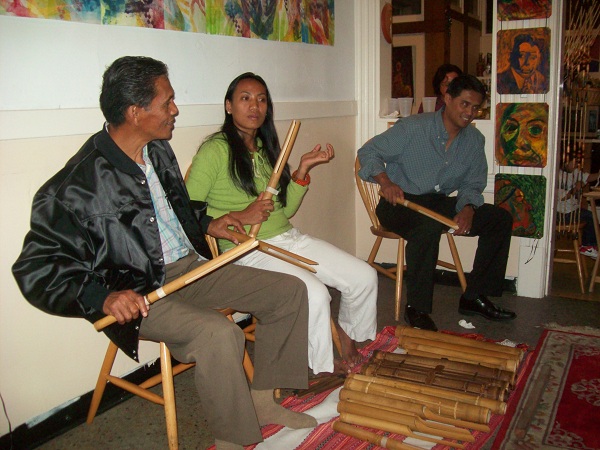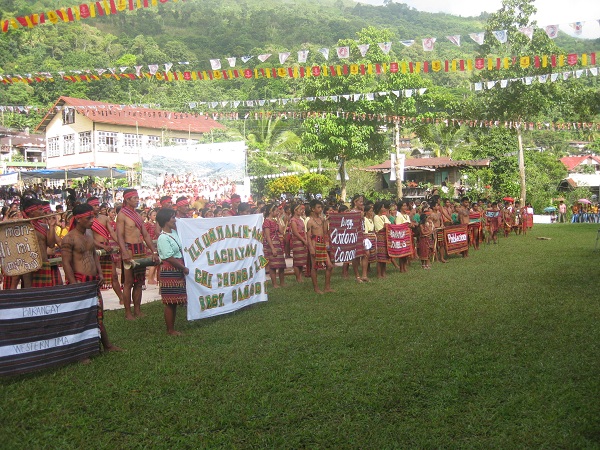I’m honored to be an ACTA Apprentice, and to have this opportunity to learn Kalinga Backstrap Weaving from Jenny Bawer Young. The Alliance for California Traditional Arts (ACTA) has enabled me to manifest a desire to learn and practice traditional arts, something I envisioned for over ten years while still painting and printmaking in San Francisco. The road leading me to this apprenticeship and to Jenny Bawer Young is literally based on my feet, through dance.
We first met a few years back at the Malonga Center for the Arts in Oakland, California, during a special workshop on tribal dances of the Cordillera Mountains held for the Likha Pilipino Folk Ensemble. Having studied many world dance forms, I was delighted to learn the dance and music practices of the tribal peoples of the Philippines. As a student of Maguindanaoan Kulintang Master Danongan Kalanduyan, and performing member of Palibuniyan Kulintang Ensemble, I was more familiar with music and dance from Mindanao and the Sulu Archipelago than the gangsa music where my family was from, Luzon.

Manong Cirilio “Sapi” Bawer (far left), with daughter Mimi (seated next to Marcos Rabara), lead a music workshop in San Francisco (2007).
In 2008 I traveled throughout the Cordilleras, where I conducted research on the relationship between contemporary and tribal art forms. In addition to spending time with the “Father of Philippine Filmaking,” Kidlat Tahimik, I was able to meet Kalinga Culture Bearer and father of Jenny, Mr. Cirilio “Sapi” Bawer, the tribal elder who introduced Kalinga music and dance to the world through the famous Bayanihan Dance Company. I was particularly happy to spend time in Lubuagan and was invited back to participate in the 100th Year of Provincial Government celebration in the summer of 2008 where I was presented a special tapis (skirt) by the Mabilong weavers. Dozens of weavers prepared months in advance for this celebration and specifically wove this particular design of the tapis for the Mabilong community.

Mabilong weaver prepares for Lumin-Awa Festival.

Mabilong Elders overlook Lubuagen, Kalinga in preparation for Lumin-Awa Festival.

Mabilong Weavers begin procession in Lubuagen to town square from Mabilong.

Mabilong Community gathered in town square of Lubuagen.

Entire town of Lubuagen gathered before music & dance celebrations begin.
Mr. Bawer, his daughter, Jenny, and other Kalinga elders, such as Manong Napoleon Batalao, have shared their wealth of knowledge in Kalinga dance, music and ritual with Filipino performing artists of the San Francisco Bay Area. Jenny Bawer Young has consulted with my performing group, DIWA, the all-female music and dance group initially formed to practice kulintang music. Her participation as creative consultant to our group has enabled us to add Kalinga music, dance and culture to our repertoire. As a culture bearer of the Philippines, she has been critical to maintaining her traditional culture while living in California.
As my friendship with Jenny grew, we came to share other passions as well, this time it was in the visual arts. Through a casual conversation I was to learn that her greatest passion was weaving. Little did she know that I had a small collection of textile weavings from Latin America. Nor did she know that I first fell in love with traditional Filipino weaving of the T’boli called T’nalak, which is made from the abaca tree. She also didn’t know that I had loved making headpiece regalia for the Bahaina section of Carlos Aceituno’s Fogo Na Roupa for San Francisco’s Carnaval and Oakland’s Carijama celebrations.
The relationship a dancer has with his or her regalia is significant, especially when the dancer creates his or her own regalia. These experiences are meaningful on a spiritual and soulful level and they become more so after one dances in their regalia. I was honored to have the tapis given to me by her family in Lubuagan and had danced with her family in the celebration before thousands of people. I am ecstatic at having the opportunity to learn to weave the traditional Kalinga belt and tapis necessary for performing Kalinga music and dance. Most often, performing artists have to travel to the Philippines and/or purchase the regalia from people who collect the textiles. In December, 2011, both she and I were doubly surprised to receive this apprenticeship. The opportunity to weave had finally arrived for me!
My first lesson actually took place amongst other DIWA members at one of our rehearsals in Castro Valley. Weaving, Kalinga style, is a group activity, at least it was that day at our rehearsal. DIWA members and I tried our best to roll perfect balls of string. This activity reminded me of a quiet evening in Lubuagan sitting with Jenny’s mother, Maria, enjoying time after our evening meal while she steadily spun a ball of yarn, explaining to me that this was the most important part of the weaving.
All photos by Holly Calica.
